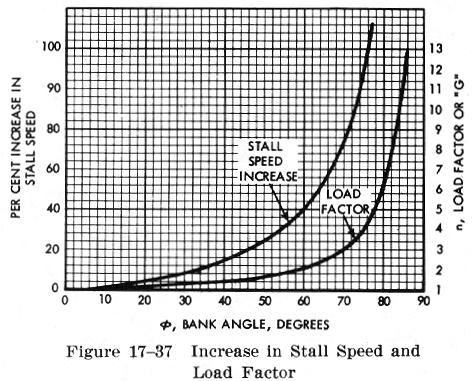Stalls
Stalls
In earlier discussions it was shown that an airplane will
fly as long as the wing is creating sufficient lift to counteract the load
imposed on it. When the lift is completely lost, the airplane stalls.
Remember, the direct cause of every stall is an excessive
angle of attack. There are any number of flight maneuvers which may produce
an increase in the angle of attack, but the stall does not occur until
the angle of attack becomes excessive.
It must be emphasized that the stalling speed of a particular
airplane is not a fixed value for all flight situations. However, a given
airplane will always stall at the same angle of attack regardless of airspeed,
weight, load factor, or density altitude. Each airplane has a particular
angle of attack where the airflow separates from the upper surface of the
wing and the stall occurs. This critical angle of attack varies from 16
to 20 degrees depending on the airplane's design. But each airplane has
only one specific angle of attack where the stall occurs.
There are three situations in which the critical angle
of attack can be exceeded - in low speed flying, in high speed flying,
and in turning flight.
| The airplane can be stalled in straight and level flight
by flying too slowly. As the airspeed is being decreased, the angle of
attack must be increased to retain the lift required for maintaining altitude.
The slower the airspeed becomes the more the angle of attack must be increased.
Eventually an angle of attack is reached which will result in the wing
not producing enough lift to support the airplane and it will start settling.
If the airspeed is reduced further the airplane will stall, since the angle
of attack has exceeded the critical angle and the airflow over the wing
is disrupted.
It must be reemphasized here that low speed is not necessary to produce
a stall. The wing can be brought into an excessive angle of attack at any
speed. For example, take the case of an airplane which is in a dive with
an airspeed of 200 knots when suddenly the pilot pulls back sharply on
the elevator control (Fig. 17-36). Because of gravity and centrifugal force,
the airplane could not immediately alter its flight path but would merely
change its angle of attack abruptly from quite low to very high. Since
the flightpath of the airplane |
|
in relation to the oncoming air determines the direction of the relative
wind, the angle of attack is suddenly increased, and the airplane would
quickly reach the stalling angle at a speed much greater than the normal
stall speed.
 |
Similarly, the stalling speed of an airplane is higher in a level turn
than in straight and level flight (Fig. 17-37). This is because centrifugal
force is added to the airplane's weight, and the wing must produce sufficient
additional lift to counterbalance the load imposed by the combination of
centrifugal force and weight. In a turn, the necessary additional lift
is acquired by applying back pressure to the elevator control.
This increases the wing's angle of attack, and results in increased
lift. As stated earlier, the angle of attack must increase as the bank
angle increases to counteract the increasing load caused by centrifugal
force. If at any time during a turn the angle of attack becomes excessive,
the airplane will stall. |
At this point we should examine the action of the airplane
during a stall. In our earlier discussion of pitching (longitudinal) stability,
we learned that to balance the airplane aerodynamically, the center of
lift is normally located aft of the center of gravity. It was also pointed
out that although this made the airplane inherently "nose heavy," downwash
on the horizontal stabilizer counteracted this condition. It can be seen
then, that at the point of stall when the upward force of the wing's lift
and the downward tail force cease, an unbalanced condition exists. This
allows the airplane to pitch down abruptly, rotating about its center of
gravity. During this nose down attitude the angle of attack decreases and
the airspeed again increases; hence, the smooth flow of air over the wing
begins again, lift returns, and the airplane is again flying. However,
considerable altitude may be lost before this cycle is complete.

